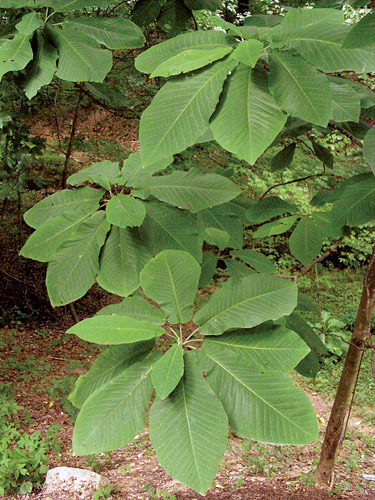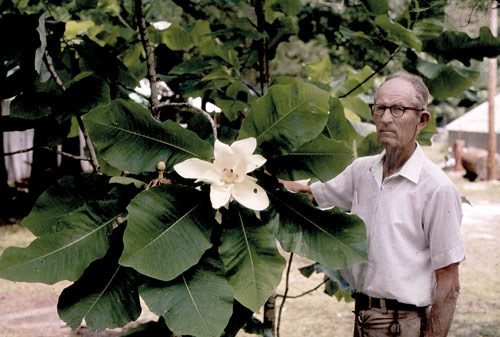Admiring bigleaf
By Ken Moore
Gardening friends Sally Heiney and Bill Bracey live on opposite sides of Carrboro and both have bigleaf magnolias planted where they can enjoy them from above – Sally from her deck and Bill from his hillside patio. I have been unable to shake the dramatic image of bigleaf’s summer foliage since sitting above them a week ago.
Colonial American botanist/naturalist William Bartram must have been equally impressed with this deciduous magnolia when he first saw it in the late spring of 1776. He was not only an energetic and brave wilderness explorer, but a keen observer, gifted in narrative descriptive skills.
He dedicated a very long paragraph in his The Travels of William Bartram to bigleaf magnolia, Magnolia macrophylla. Following is a selection of his single-sentence verbal portrait of the tree:
“This tree … rises eighteen to thirty feet in height, there are usually many stems from a root or source, which lean a little, or slightly diverge from each other, in this respect imitating the Magnolia tripetala; the crooked wreathing branches arising and subdividing from the main stem without order or uniformity, their extremities turn upwards, producing … the center of a radius of very large leaves, which are of a singular figure, somewhat lanceolate, but broad towards their extremities, terminating with an acuminated point, and backwards they attenuate and become very narrow towards their bases, terminating that way with two long, narrow ears or lappets, one on each side of the insertion of the petiole; the leaves … spread themselves after a regular order, like the spokes of a wheel, their margins touching or lightly lapping upon each other, form an expansive umbrella …â€
This excerpt gives a vivid account of the tree’s characteristic habit and the specifics of the leaves that are commonly more than two feet long. Whether looking down on them or peering up through the tree’s tropical-like canopy, Magnolia macro (big) phyla (leaf) is impressive.
Bartram included many more lines in his verbal painting of the tree’s flower. My favorite flower image is a ‘70s color slide of Gordon Butler, gently holding a flowering branch of the tree in the front yard of Butler’s Nursery just outside Fayetteville.
Way back before it was fashionable, Gordon Butler, first recipient, in 1972, of the North Carolina Nurseryman of the Year Award (D.S. Copeland Award) propagated, cultivated and promoted our native trees and shrubs for ornamental use in home and urban landscapes. Far out front and ahead of the times, was he!
Bigleaf, infrequently and widely scattered throughout the Southeast, is only seen in our area in cultivation. It’s in cultivation at the Botanical Garden and the Coker Arboretum. Perhaps you have savvy garden friends like Sally and Bill who have their own bigleaf. Even without a high vantage point, you should have one growing in your garden. Plan now to have one procured for you by your local nursery or garden center for fall or winter planting.
Early in his description, Bartram referred to the commoner Magnolia tripetala, umbrella magnolia; that’s the one we see along stream banks in our local forests. The leaves are not as large as bigleaf’s and the leaf bases do not have those distinctive ear lobes, but it is still a dramatic tree and worthy of your inquiries at local nurseries.




Comments are closed.